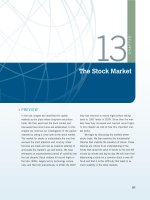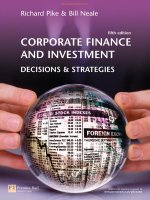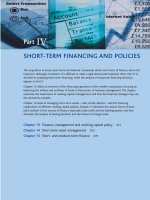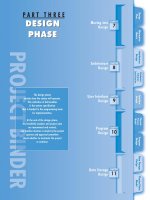Ebook Macroeconomics principles and policy (11th edition): Part 1
Bạn đang xem bản rút gọn của tài liệu. Xem và tải ngay bản đầy đủ của tài liệu tại đây (6.86 MB, 222 trang )
Find more at www.downloadslide.com
Find more at www.downloadslide.com
MACROECONOMICS
Principles and Policy
Eleventh Edition
Find more at www.downloadslide.com
Find more at www.downloadslide.com
MACROECONOMICS
Principles and Policy
Eleventh Edition
William J. Baumol
New York University and Princeton University
Alan S. Blinder
Princeton University
Australia • Brazil • Japan • Korea • Mexico • Singapore • Spain • United Kingdom • United States
Find more at www.downloadslide.com
Macroeconomics: Principles and Policy, 11e
William J. Baumol, Alan S. Blinder
VP/Editorial Director: Jack W. Calhoun
Editor-in-Chief: Alex von Rosenburg
Executive Editor: Mike Worls
Developmental Editor: Katie Yanos
Marketing Manager: John Carey
Marketing Communications Manager: Sarah
Greber
Content Project Manager: Heather Mann
Manager, Editorial Media: John Barans
Technology Project Editor: Deepak Kumar
Senior Buyer—Manufacturing: Sandee Milewski
Production Service: Pre-PressPMG
Compositor: Pre-PressPMG
Senior Art Director: Michelle Kunkler
Cover Design: Lisa Albonetti
Internal Design: Lisa Albonetti
Cover Images: © Getty Images; © First Light
Associated Photographers, Inc.
Senior Permissions Rights Acquisitions Account
Manager—Images: Deanna Ettinger
© 2009 South-Western Cengage Learning
ALL RIGHTS RESERVED. No part of this work covered by the copyright herein
may be reproduced, transmitted, stored or used in any form or by any means
graphic, electronic, or mechanical, including but not limited to photocopying,
recording, scanning, digitizing, taping, Web distribution, information networks,
or information storage and retrieval systems, except as permitted under
Section 107 or 108 of the 1976 United States Copyright Act, without the prior
written permission of the publisher.
For product information and technology assistance, contact us at
Cengage Learning Academic Resource Center, 1-800-423-0563
For permission to use material from this text or product,
submit all requests online at www.cengage.com/permissions
Further permissions questions can be emailed to
ExamView® and ExamView Pro® are registered trademarks of FSCreations,
Inc. Windows® is a registered trademark of the Microsoft Corporation used
herein under license.
Library of Congress Control Number: 2007922480
Library of Congress Control Number: 2008926814
Student Edition ISBN-13: 978-0-324-58621-3
Student Edition ISBN-10: 0-324-58621-3
Instructor’s Edition ISBN-13: 978-0-324-58631-2
Instructor’s Edition ISBN-10: 0-324-58631-0
South-Western Cengage Learning
5191 Natorp Boulevard
Mason, OH 45040
USA
Cengage Learning products are represented in Canada by Nelson Education, Ltd.
For your course and learning solutions, visit academic.cengage.com
Purchase any of our products at your local college store or at our preferred
online store www.ichapters.com
Printed in the United States
1 2 3 4 5 6 7 12 11 10 09 08
Find more at www.downloadslide.com
About the Authors
WILLIAM J. BAUMOL
William J. Baumol was born in New York City and received his BSS at the
College of the City of New York and his Ph.D. at the University of London.
He is the Harold Price Professor of Entrepreneurship and Academic Director
of the Berkley Center for Entrepreneurial Studies at New York University,
where he teaches a course in introductory microeconomics, and the Joseph
Douglas Green, 1895, Professor of Economics Emeritus and Senior Economist
at Princeton University. He is a frequent consultant to the management of
major firms in a wide variety of industries in the United States and other countries as well as to a number of governmental agencies. In several fields, including the telecommunications and electric utility industries, current regulatory
policy is based on his explicit recommendations. Among his many
contributions to economics are research on the theory of the firm, the contestability of markets, the economics of the arts and other services—the “cost disease of the services” is often referred to as “Baumol’s disease“—and economic
growth, entrepreneurship, and innovation. In addition to economics, he taught
a course in wood sculpture at Princeton for about 20 years and is an accomAlan Blinder and Will Baumol
plished painter (you may view some of his paintings at
/>Professor Baumol has been president of the American Economic Association and
three other professional societies. He is an elected member of the National Academy of
Sciences, created by the U.S. Congress, and of the American Philosophical Society,
founded by Benjamin Franklin. He is also on the board of trustees of the National Council
on Economic Education and of the Theater Development Fund. He is the recipient of
11 honorary degrees.
Baumol is the author of more than 35 books and hundreds of journal and newspaper
articles. His writings have been translated into more than a dozen languages.
ALAN S. BLINDER
Alan S. Blinder was born in New York City and attended Princeton University, where
one of his teachers was William Baumol. After earning a master’s degree at the London
School of Economics and a Ph.D. at MIT, Blinder returned to Princeton, where he has
taught since 1971, including teaching introductory macroeconomics since 1977. He is
currently the Gordon S. Rentschler Memorial Professor of Economics and co-director of
Princeton’s Center for Economic Policy Studies, which he founded.
In January 1993, Blinder went to Washington as part of President Clinton’s first Council of Economic Advisers. Then, from June 1994 through January 1996, he served as vice
chairman of the Federal Reserve Board. He thus played a role in formulating both the
fiscal and monetary policies of the 1990s, topics discussed extensively in this book. He
has also advised several presidential campaigns.
Blinder has consulted for a number of the world’s largest financial institutions, testified dozens of times before congressional committees, and been involved in several entrepreneurial start-ups. For many years, he has written newspaper and magazine articles on
economic policy, and he currently has a regular column in the New York Times Sunday
Business Section. In addition, Blinder’s op-ed pieces still appear periodically in other
newspapers. He also appears frequently on PBS, CNN, CNBC, and Bloomberg TV.
v
Find more at www.downloadslide.com
vi
About the Authors
Blinder has served as president of the Eastern Economic Association and vice president of the American Economic Association and is a member of the American Philosophical Society, the American Academy of Arts and Sciences, and the Council on Foreign
Relations. He has two grown sons, two grandsons, and lives in Princeton with his wife,
where he plays tennis as often as he can.
Find more at www.downloadslide.com
Brief Contents
PART 1
GETTING ACQUAINTED WITH ECONOMICS
Chapter
Chapter
Chapter
Chapter
PART 2
THE MACROECONOMY: AGGREGATE SUPPLY AND DEMAND
Chapter
Chapter
Chapter
Chapter
Chapter
Chapter
PART 3
5
6
7
8
9
10
An Introduction to Macroeconomics 83
The Goals of Macroeconomic Policy 105
Economic Growth: Theory and Policy 133
Aggregate Demand and the Powerful Consumer 153
Demand-Side Equilibrium: Unemployment or Inflation? 175
Bringing in the Supply-Side: Unemployment and Inflation? 199
FISCAL AND MONETARY POLICY
Chapter
Chapter
Chapter
Chapter
Chapter
Chapter
PART 4
1 What Is Economics? 3
2 The Economy: Myth and Reality 21
3 The Fundamental Economic Problem: Scarcity and Choice 39
4 Supply and Demand: An Initial Look 55
11
12
13
14
15
16
Managing Aggregate Demand: Fiscal Policy 221
Money and the Banking System 241
Managing Aggregate Demand: Monetary Policy 261
The Debate over Monetary and Fiscal Policy 277
Budget Deficits in the short and long run 299
The Trade-Off Between Inflation and Unemployment 317
THE UNITED STATES IN THE WORLD ECONOMY
Chapter 17 International Trade and Comparative Advantage 339
Chapter 18 The International Monetary System: Order or Disorder? 361
Chapter 19 Exchange Rates and the Macroeconomy 379
vii
Find more at www.downloadslide.com
Find more at www.downloadslide.com
Table of Contents
Preface xix
PART 1
Chapter 1
GETTING ACQUAINTED WITH ECONOMICS 1
What Is Economics? 3
IDEAS FOR BEYOND THE FINAL EXAM 4
Idea 1: How Much Does It Really Cost? 4
Idea 2: Attempts to Repeal the Laws of Supply and Demand—The Market Strikes Back 5
Idea 3: The Surprising Principle of Comparative Advantage 5
Idea 4: Trade Is a Win-Win Situation 5
Idea 5: Government Policies Can Limit Economic Fluctuations—But Don’t Always Succeed 6
Idea 6: The Short-Run Trade-Off between Inflation and Unemployment 6
Idea 7: Productivity Growth Is (Almost) Everything in the Long Run 6
Epilogue 7
INSIDE THE ECONOMIST’S TOOL KIT 7
Economics as a Discipline 7
The Need for Abstraction 7
The Role of Economic Theory 9
What Is an Economic Model? 10
Reasons for Disagreements: Imperfect Information and Value Judgments 11
Summary 12
Key Terms 12
Discussion Questions 12
APPENDIX: USING GRAPHS: A REVIEW 13
Graphs Used in Economic Analysis 13
Two-Variable Diagrams 13
The Definition and Measurement of Slope 14
Rays Through the Origin and 45° Lines 16
Squeezing Three Dimensions into Two: Contour Maps 17
Summary 18
Key Terms 18
Test Yourself 18
Chapter 2
The Economy: Myth and Reality 21
THE AMERICAN ECONOMY: A THUMBNAIL SKETCH 22
A Private-Enterprise Economy 23
A Relatively “Closed” Economy 23
A Growing Economy . . . 24
But with Bumps along the Growth Path 24
THE INPUTS: LABOR AND CAPITAL 26
The American Workforce: Who Is in It? 27
The American Workforce: What Does It Do? 28
The American Workforce: What It Earns 29
Capital and Its Earnings 30
THE OUTPUTS: WHAT DOES AMERICA PRODUCE? 30
THE CENTRAL ROLE OF BUSINESS FIRMS 31
WHAT’S MISSING FROM THE PICTURE? GOVERNMENT 32
The Government as Referee 33
The Government as Business Regulator 33
ix
Find more at www.downloadslide.com
x
Contents
Government Expenditures 34
Taxes in America 35
The Government as Redistributor 36
CONCLUSION: IT’S A MIXED ECONOMY 36
Summary 36
Key Terms 37
Discussion Questions 37
Chapter 3
The Fundamental Economic Problem: Scarcity and Choice 39
ISSUE: WHAT TO DO ABOUT THE BUDGET DEFICIT? 40
SCARCITY, CHOICE, AND OPPORTUNITY COST 40
Opportunity Cost and Money Cost 41
Optimal Choice: Not Just Any Choice 42
SCARCITY AND CHOICE FOR A SINGLE FIRM 42
The Production Possibilities Frontier 43
The Principle of Increasing Costs 44
SCARCITY AND CHOICE FOR THE ENTIRE SOCIETY 45
Scarcity and Choice Elsewhere in the Economy 45
ISSUE REVISITED: COPING WITH THE BUDGET DEFICIT 46
THE CONCEPT OF EFFICIENCY 47
THE THREE COORDINATION TASKS OF ANY ECONOMY 48
SPECIALIZATION FOSTERS EFFICIENT RESOURCE ALLOCATION 48
The Wonders of the Division of Labor 48
The Amazing Principle of Comparative Advantage 49
SPECIALIZATION LEADS TO EXCHANGE 50
MARKETS, PRICES, AND THE THREE COORDINATION TASKS 50
LAST WORD: DON’T CONFUSE ENDS WITH MEANS 52
Summary 52
Key Terms 53
Test Yourself 53
Discussion Questions 53
Chapter 4
Supply and Demand: An Initial Look
55
PUZZLE: WHAT HAPPENED TO OIL PRICES? 56
THE INVISIBLE HAND 56
DEMAND AND QUANTITY DEMANDED 57
The Demand Schedule 58
The Demand Curve 58
Shifts of the Demand Curve 58
SUPPLY AND QUANTITY SUPPLIED 61
The Supply Schedule and the Supply Curve 61
Shifts of the Supply Curve 62
SUPPLY AND DEMAND EQUILIBRIUM 64
The Law of Supply and Demand 66
EFFECTS OF DEMAND SHIFTS ON SUPPLY-DEMAND EQUILIBRIUM 66
SUPPLY SHIFTS AND SUPPLY-DEMAND EQUILIBRIUM 67
THOSE LEAPING OIL PRICES: PUZZLE RESOLVED 68
Application: Who Really Pays that Tax? 69
BATTLING THE INVISIBLE HAND: THE MARKET FIGHTS BACK 70
Restraining the Market Mechanism: Price Ceilings 70
Case Study: Rent Controls in New York City 72
Restraining the Market Mechanism: Price Floors 73
Case Study: Farm Price Supports and the Case of Sugar Prices 74
A Can of Worms 75
Find more at www.downloadslide.com
Contents
A SIMPLE BUT POWERFUL LESSON 76
Summary 76
Key Terms 77
Test Yourself 77
Discussion Questions 78
PART 2
Chapter 5
THE MACROECONOMY: AGGREGATE SUPPLY AND DEMAND 81
An Introduction to Macroeconomics 83
ISSUE: WHY DID GROWTH SLOW IN 2006-2007? 84
DRAWING A LINE BETWEEN MACROECONOMICS AND MICROECONOMICS 84
Aggregation and Macroeconomics 84
The Foundations of Aggregation 85
The Line of Demarcation Revisited 85
SUPPLY AND DEMAND IN MACROECONOMICS 85
A Quick Review 86
Moving to Macroeconomic Aggregates 86
Inflation 87
Recession and Unemployment 87
Economic Growth 87
GROSS DOMESTIC PRODUCT 87
Money as the Measuring Rod: Real versus Nominal GDP 88
What Gets Counted in GDP? 88
Limitations of the GDP: What GDP Is Not 90
THE ECONOMY ON A ROLLER COASTER 91
Growth, but with Fluctuations 91
Inflation and Deflation 93
The Great Depression 94
From World War II to 1973 95
The Great Stagflation, 1973–1980 96
Reaganomics and Its Aftermath 97
Clintonomics: Deficit Reduction and the “New Economy” 97
Tax Cuts and the Bush Economy 98
ISSUE REVISITED: WAS IT GEORGE BUSH’S FAULT? 99
THE PROBLEM OF MACROECONOMIC STABILIZATION: A SNEAK PREVIEW 99
Combating Unemployment 99
Combating Inflation 100
Does It Really Work? 100
Summary 101
Key Terms 102
Test Yourself 102
Discussion Questions 103
Chapter 6
The Goals of Macroeconomic Policy 105
PART 1: THE GOAL OF ECONOMIC GROWTH 106
PRODUCTIVITY GROWTH: FROM LITTLE ACORNS . . . 106
ISSUE: IS FASTER GROWTH ALWAYS BETTER? 108
THE CAPACITY TO PRODUCE: POTENTIAL GDP AND THE PRODUCTION FUNCTION 108
THE GROWTH RATE OF POTENTIAL GDP 109
ISSUE REVISITED: IS FASTER GROWTH ALWAYS BETTER? 110
PART 2: THE GOAL OF LOW UNEMPLOYMENT 111
THE HUMAN COSTS OF HIGH UNEMPLOYMENT 112
COUNTING THE UNEMPLOYED: THE OFFICIAL STATISTICS 113
TYPES OF UNEMPLOYMENT 114
xi
Find more at www.downloadslide.com
xii
Contents
HOW MUCH EMPLOYMENT IS “FULL EMPLOYMENT”? 115
UNEMPLOYMENT INSURANCE: THE INVALUABLE CUSHION 115
PART 3: THE GOAL OF LOW INFLATION 116
INFLATION: THE MYTH AND THE REALITY 117
Inflation and Real Wages 117
The Importance of Relative Prices 119
INFLATION AS A REDISTRIBUTOR OF INCOME AND WEALTH 120
REAL VERSUS NOMINAL INTEREST RATES 120
INFLATION DISTORTS MEASUREMENTS 121
Confusing Real and Nominal Interest Rates 122
The Malfunctioning Tax System 122
OTHER COSTS OF INFLATION 122
THE COSTS OF LOW VERSUS HIGH INFLATION 123
LOW INFLATION DOES NOT NECESSARILY LEAD TO HIGH INFLATION 125
Summary 125
Key Terms 126
Test Yourself 126
Discussion Questions 127
APPENDIX: HOW STATISTICIANS MEASURE INFLATION 127
Index Numbers for Inflation 127
The Consumer Price Index 128
Using a Price Index to “Deflate” Monetary Figures 128
Using a Price Index to Measure Inflation 129
The GDP Deflator 129
Summary 130
Key Terms 130
Test Yourself 130
Chapter 7
Economic Growth: Theory and Policy 133
PUZZLE: WHY DOES COLLEGE EDUCATION KEEP GETTING MORE EXPENSIVE? 134
THE THREE PILLARS OF PRODUCTIVITY GROWTH 134
Capital 135
Technology 135
Labor Quality: Education and Training 136
LEVELS, GROWTH RATES, AND THE CONVERGENCE HYPOTHESIS 136
GROWTH POLICY: ENCOURAGING CAPITAL FORMATION 138
GROWTH POLICY: IMPROVING EDUCATION AND TRAINING 140
GROWTH POLICY: SPURRING TECHNOLOGICAL CHANGE 142
THE PRODUCTIVITY SLOWDOWN AND SPEED-UP IN THE UNITED STATES 143
The Productivity Slowdown, 1973–1995 143
The Productivity Speed-up, 1995–? 144
PUZZLE RESOLVED: WHY THE RELATIVE PRICE OF COLLEGE TUITION KEEPS RISING 146
GROWTH IN THE DEVELOPING COUNTRIES 147
The Three Pillars Revisited 147
Some Special Problems of the Developing Countries 148
FROM THE LONG RUN TO THE SHORT RUN 149
Summary 149
Key Terms 150
Test Yourself 150
Discussion Questions 151
Chapter 8
Aggregate Demand and the Powerful Consumer 153
ISSUE: DEMAND MANAGEMENT AND THE ORNERY CONSUMER 154
AGGREGATE DEMAND, DOMESTIC PRODUCT, AND NATIONAL INCOME 154
Find more at www.downloadslide.com
Contents
THE CIRCULAR FLOW OF SPENDING, PRODUCTION, AND INCOME 155
CONSUMER SPENDING AND INCOME: THE IMPORTANT RELATIONSHIP 157
THE CONSUMPTION FUNCTION AND THE MARGINAL PROPENSITY TO CONSUME 160
FACTORS THAT SHIFT THE CONSUMPTION FUNCTION 161
ISSUE REVISITED: WHY THE TAX REBATES FAILED IN 1975 AND 2001 162
THE EXTREME VARIABILITY OF INVESTMENT 164
THE DETERMINANTS OF NET EXPORTS 165
National Incomes 165
Relative Prices and Exchange Rates 165
HOW PREDICTABLE IS AGGREGATE DEMAND? 166
Summary 166
Key Terms 167
Test Yourself 167
Discussion Questions 168
APPENDIX: NATIONAL INCOME ACCOUNTING 168
Defining GDP: Exceptions to the Rules 168
GDP as the Sum of Final Goods and Services 169
GDP as the Sum of All Factor Payments 169
GDP as the Sum of Values Added 171
Summary 172
Key Terms 173
Test Yourself 173
Discussion Questions 174
Chapter 9
Demand-Side Equilibrium: Unemployment or Inflation? 175
ISSUE: WHY DOES THE MARKET PERMIT UNEMPLOYMENT? 176
THE MEANING OF EQUILIBRIUM GDP 176
THE MECHANICS OF INCOME DETERMINATION 178
THE AGGREGATE DEMAND CURVE 180
DEMAND-SIDE EQUILIBRIUM AND FULL EMPLOYMENT 182
THE COORDINATION OF SAVING AND INVESTMENT 183
CHANGES ON THE DEMAND SIDE: MULTIPLIER ANALYSIS 185
The Magic of the Multiplier 185
Demystifying the Multiplier: How It Works 186
Algebraic Statement of the Multiplier 187
THE MULTIPLIER IS A GENERAL CONCEPT 189
THE MULTIPLIER AND THE AGGREGATE DEMAND CURVE 190
Summary 191
Key Terms 192
Test Yourself 192
Discussion Questions 193
APPENDIX A: THE SIMPLE ALGEBRA OF INCOME DETERMINATION AND THE MULTIPLIER 193
Test Yourself 194
Discussion Questions 194
APPENDIX B: THE MULTIPLIER WITH VARIABLE IMPORTS 194
Summary 197
Test Yourself 197
Discussion Question 197
Chapter 10 Bringing in the Supply-Side: Unemployment and Inflation? 199
PUZZLE: WHAT CAUSES STAGFLATION? 200
THE AGGREGATE SUPPLY CURVE 200
Why the Aggregate Supply Curve Slopes Upward 200
Shifts of the Agregate Supply Curve 201
xiii
Find more at www.downloadslide.com
Contents
xiv
EQUILIBRIUM OF AGGREGATE DEMAND AND SUPPLY 203
INFLATION AND THE MULTIPLIER 204
RECESSIONARY AND INFLATIONARY GAPS REVISITED 205
ADJUSTING TO A RECESSIONARY GAP: DEFLATION OR UNEMPLOYMENT? 207
Why Nominal Wages and Prices Won’t Fall (Easily) 207
Does the Economy Have a Self-Correcting Mechanism? 208
An example from Recent History: Deflation in Japan 209
ADJUSTING TO AN INFLATIONARY GAP: INFLATION 209
Demand Inflation and Stagflation 210
A U.S. Example 210
STAGFLATION FROM A SUPPLY SHOCK 211
APPLYING THE MODEL TO A GROWING ECONOMY 212
Demand-Side Fluctuations 213
Supply-Side Fluctuations 214
PUZZLE RESOLVED: EXPLAINING STAGFLATION 216
A ROLE FOR STABILIZATION POLICY 216
Summary 216
Key Terms 217
Test Yourself 217
Discussion Questions 218
PART 3
FISCAL AND MONETARY POLICY 219
Chapter 11 Managing Aggregate Demand: Fiscal Policy 221
ISSUE: AGGREGATE DEMAND, AGGREGATE SUPPLY, AND THE CAMPAIGN OF 2008 222
INCOME TAXES AND THE CONSUMPTION SCHEDULE 222
THE MULTIPLIER REVISITED 223
The Tax Multiplier 223
Income Taxes and the Multiplier 224
Automatic Stabilizers 225
Government Transfer Payments 225
ISSUE REVISITED: THE 2008 DEBATE OVER TAXES AND SPENDING 226
PLANNING EXPANSIONARY FISCAL POLICY 226
PLANNING CONTRACTIONARY FISCAL POLICY 227
THE CHOICE BETWEEN SPENDING POLICY AND TAX POLICY 227
ISSUE REDUX: DEMOCRATS VERSUS REPUBLICANS 228
SOME HARSH REALITIES 228
THE IDEA BEHIND SUPPLY-SIDE TAX CUTS 229
Some Flies in the Ointment 230
ISSUE: THE PARTISAN DEBATE ONCE MORE 231
Toward an Assessment of Supply-Side Economics 232
Summary 233
Key Terms 233
Test Yourself 234
Discussion Questions 234
| APPENDIX A | GRAPHICAL TREATMENT OF TAXES AND FISCAL POLICY 235
MULTIPLIERS FOR TAX POLICY 237
Summary 237
Key Terms 237
Test Yourself 238
Discussion Questions 238
| APPENDIX B | ALGEBRAIC TREATMENT OF TAXES AND FISCAL POLICY 238
Test Yourself 240
Find more at www.downloadslide.com
Contents
Chapter 12 Money and the Banking System 241
ISSUE: WHY ARE BANKS SO HEAVILY REGULATED? 242
THE NATURE OF MONEY 242
Barter versus Monetary Exchange 243
The Conceptual Definition of Money 244
What Serves as Money? 244
HOW THE QUANTITY OF MONEY IS MEASURED 246
M1 246
M2 247
Other Definitions of the Money Supply 247
THE BANKING SYSTEM 248
How Banking Began 248
Principles of Bank Management: Profits versus Safety 250
Bank Regulation 250
THE ORIGINS OF THE MONEY SUPPLY 251
How Bankers Keep Books 251
BANKS AND MONEY CREATION 252
The Limits to Money Creation by a Single Bank 252
Multiple Money Creation by a Series of Banks 254
The Process in Reverse: Multiple Contractions of the Money Supply 256
WHY THE MONEY-CREATION FORMULA IS OVERSIMPLIFIED 258
THE NEED FOR MONETARY POLICY 259
Summary 259
Key Terms 260
Test Yourself 260
Discussion Questions 260
Chapter 13 Managing Aggregate Demand: Monetary Policy 261
ISSUE: JUST WHY IS BEN BERNANKE SO IMPORTANT? 262
MONEY AND INCOME: THE IMPORTANT DIFFERENCE 262
AMERICA’S CENTRAL BANK: THE FEDERAL RESERVE SYSTEM 263
Origins and Structure 263
Central Bank Independence 264
IMPLEMENTING MONETARY POLICY: OPEN-MARKET OPERATIONS 265
The Market for Bank Reserves 265
The Mechanics of an Open-Market Operation 266
Open-Market Operations, Bond Prices, and Interest Rates 268
OTHER METHODS OF MONETARY CONTROL 268
Lending to Banks 269
Changing Reserve Requirements 270
HOW MONETARY POLICY WORKS 270
Investment and Interest Rates 271
Monetary Policy and Total Expenditure 271
MONEY AND THE PRICE LEVEL IN THE KEYNESIAN MODEL 272
Application: Why the Aggregate Demand Curve Slopes Downward 273
FROM MODELS TO POLICY DEBATES 274
Summary 274
Key Terms 275
Test Yourself 275
Discussion Questions 276
Chapter 14 The Debate Over Monetary and Fiscal Policy 277
ISSUE: SHOULD WE FORSAKE STABILIZATION POLICY? 278
xv
Find more at www.downloadslide.com
xvi
Contents
VELOCITY AND THE QUANTITY THEORY OF MONEY 278
Some Determinants of Velocity 280
Monetarism: The Quantity Theory Modernized 281
FISCAL POLICY, INTEREST RATES, AND VELOCITY 281
Application: The Multiplier Formula Revisited 282
Application: The Government Budget and Investment 283
DEBATE: SHOULD WE RELY ON FISCAL OR MONETARY POLICY? 283
DEBATE: SHOULD THE FED CONTROL THE MONEY SUPPLY OR INTEREST RATES? 284
Two Imperfect Alternatives 286
What Has the Fed Actually Done? 286
DEBATE: THE SHAPE OF THE AGGREGATE SUPPLY CURVE 287
DEBATE: SHOULD THE GOVERNMENT INTERVENE? 289
Lags and the Rules-versus-Discretion Debate 291
DIMENSIONS OF THE RULES-VERSUS-DISCRETION DEBATE 291
How Fast Does the Economy’s Self-Correcting Mechanism Work? 291
How Long Are the Lags in Stabilization Policy? 292
How Accurate Are Economic Forcasts? 292
The Size of Government 292
Uncertainties Caused by Government Policy 293
A Political Business Cycle? 293
ISSUE REVISITED: WHAT SHOULD BE DONE? 295
Summary 295
Key Terms 296
Test Yourself 296
Discussion Questions 297
Chapter 15 Budget Deficits in the Short and Long Run 299
ISSUE: IS THE FEDERAL GOVERNMENT BUDGET DEFICIT TOO LARGE? 300
SHOULD THE BUDGET BE BALANCED? THE SHORT RUN 300
The Importance of the Policy Mix 301
SURPLUSES AND DEFICITS: THE LONG RUN 301
DEFICITS AND DEBT: TERMINOLOGY AND FACTS 303
Some Facts about the National Debt 303
INTERPRETING THE BUDGET DEFICIT OR SURPLUS 305
The Structural Deficit or Surplus 305
On-Budget versus Off-Budget Surpluses 307
Conclusion: What Happened after 1981? 307
WHY IS THE NATIONAL DEBT CONSIDERED A BURDEN? 307
BUDGET DEFICITS AND INFLATION 308
The Monetization Issue 309
DEBT, INTEREST RATES, AND CROWDING OUT 310
The Bottom Line 311
THE MAIN BURDEN OF THE NATIONAL DEBT: SLOWER GROWTH 311
ISSUE REVISITED: IS THE BUDGET DEFICIT TOO LARGE? 313
THE ECONOMICS AND POLITICS OF THE U.S. BUDGET DEFICIT 314
Summary 315
Key Terms 315
Test Yourself 316
Discussion Questions 316
Chapter 16 The Trade-off between Inflation and Unemployment 317
ISSUE: IS THE TRADE-OFF BETWEEN INFLATION AND UNEMPLOYMENT A RELIC OF THE PAST? 318
DEMAND-SIDE INFLATION VERSUS SUPPLY-SIDE INFLATION: A REVIEW 318
ORIGINS OF THE PHILLIPS CURVE 319
SUPPLY-SIDE INFLATION AND THE COLLAPSE OF THE PHILLIPS CURVE 321
Find more at www.downloadslide.com
Contents
Explaining the Fabulous 1990s 321
ISSUE RESOLVED: WHY INFLATION AND UNEMPLOYMENT BOTH DECLINED 322
WHAT THE PHILLIPS CURVE IS NOT 322
FIGHTING UNEMPLOYMENT WITH FISCAL AND MONETARY POLICY 324
WHAT SHOULD BE DONE? 325
The Costs of Inflation and Unemployment 325
The Slope of the (Short-Run) Phillips Curve 325
The Efficiency of the Economy’s Self-Correcting Mechanism 325
INFLATIONARY EXPECTATIONS AND THE PHILLIPS CURVE 326
THE THEORY OF RATIONAL EXPECTATIONS 328
What Are Rational Expectations? 328
Rational Expectations and the Trade-Off 329
An Evaluation 329
WHY ECONOMISTS (AND POLITICIANS) DISAGREE 330
THE DILEMMA OF DEMAND MANAGEMENT 331
ATTEMPTS TO REDUCE THE NATURAL RATE OF UNEMPLOYMENT 331
INDEXING 332
Summary 333
Key Terms 334
Test Yourself 334
Discussion Questions 334
PART 4
THE UNITED STATES IN THE WORLD ECONOMY 337
Chapter 17 International Trade and Comparative Advantage 339
ISSUE: HOW CAN AMERICANS COMPETE WITH “CHEAP FOREIGN LABOR”? 340
WHY TRADE? 341
Mutual Gains from Trade 341
INTERNATIONAL VERSUS INTRANATIONAL TRADE 342
Political Factors in International Trade 342
The Many Currencies Involved in International Trade 342
Impediments to Mobility of Labor and Capital 342
THE LAW OF COMPARATIVE ADVANTAGE 343
The Arithmetic of Comparative Advantage 343
The Graphics of Comparative Advantage 344
Must Specialization Be Complete? 347
ISSUE RESOLVED: COMPARATIVE ADVANTAGE EXPOSES THE “CHEAP FOREIGN LABOR” FALLACY 347
TARIFFS, QUOTAS, AND OTHER INTERFERENCES WITH TRADE 348
Tariffs versus Quotas 349
WHY INHIBIT TRADE? 350
Gaining a Price Advantage for Domestic Firms 350
Protecting Particular Industries 350
National Defense and Other Noneconomic Considerations 351
The Infant-Industry Argument 352
Strategic Trade Policy 353
CAN CHEAP IMPORTS HURT A COUNTRY? 353
A LAST LOOK AT THE “CHEAP FOREIGN LABOR” ARGUMENT 354
Summary 356
Key Terms 356
Test Yourself 357
Discussion Questions 357
| APPENDIX | SUPPLY, DEMAND, AND PRICING IN WORLD TRADE 358
HOW TARIFFS AND QUOTAS WORK 359
Summary 360
Test Yourself 360
xvii
Find more at www.downloadslide.com
xviii
Contents
Chapter 18 The International Monetary System: Order or Disorder? 361
PUZZLE: WHY HAS THE DOLLAR SAGGED? 362
WHAT ARE EXCHANGE RATES? 362
EXCHANGE RATE DETERMINATION IN A FREE MARKET 363
Interest Rates and Exchange Rates: The Short Run 365
Economic Activity and Exchange Rates: The Medium Run 366
The Purchasing-Power Parity Theory: The Long Run 366
Market Determination of Exchange Rates: Summary 368
WHEN GOVERNMENTS FIX EXCHANGE RATES: THE BALANCE OF PAYMENTS 369
A BIT OF HISTORY: THE GOLD STANDARD AND THE BRETTON WOODS SYSTEM 370
The Classical Gold Standard 371
The Bretton Woods System 371
ADJUSTMENT MECHANISMS UNDER FIXED EXCHANGE RATES 372
WHY TRY TO FIX EXCHANGE RATES? 372
THE CURRENT “NONSYSTEM” 373
The Role of the IMF 374
The Volatile Dollar 374
The Birth of the Euro 375
PUZZLE RESOLVED: WHY THE DOLLAR ROSE AND THEN FELL 376
Summary 377
Key Terms 377
Test Yourself 378
Discussion Questions 378
Chapter 19 Exchange Rates and the Macroeconomy 379
ISSUE: SHOULD THE U.S. GOVERNMENT TRY TO STOP THE DOLLAR FROM FALLING? 380
INTERNATIONAL TRADE, EXCHANGE RATES, AND AGGREGATE DEMAND 380
Relative Prices, Exports, and Imports 381
The Effects of Changes in Exchange Rates 381
AGGREGATE SUPPLY IN AN OPEN ECONOMY 382
THE MACROECONOMIC EFFECTS OF EXCHANGE RATES 383
Interest Rates and International Capital Flows 384
FISCAL AND MONETARY POLICIES IN AN OPEN ECONOMY 384
Fiscal Policy Revisited 384
Monetary Policy Revisited 386
INTERNATIONAL ASPECTS OF DEFICIT REDUCTION 386
The Loose Link between the Budget Deficit and the Trade Deficit 387
SHOULD WE WORRY ABOUT THE TRADE DEFICIT? 388
ON CURING THE TRADE DEFICIT 388
Change the Mix of Fiscal and Monetary Policy 388
More Rapid Economic Growth Abroad 389
Raise Domestic Saving or Reduce Domestic Investment 389
Protectionism 389
CONCLUSION: NO NATION IS AN ISLAND 390
ISSUE REVISITED: SHOULD THE UNITED STATES LET THE DOLLAR FALL? 391
Summary 391
Key Terms 392
Test Yourself 392
Discussion Questions 392
| APPENDIX | Answers to Odd-Numbered Test Yourself Questions 393
Glossary 405
Index 413
Find more at www.downloadslide.com
Preface
A
s usual, when preparing a new edition, we have made many small changes to
improve clarity of exposition and to update the text both for recent economics
events and for relevant advances in the literature. But this time we have focused on one
particular addition that will, so far as we have been able to find out, differentiate this book
from all other introductory texts.
We have included in the eleventh edition a substantial discussion of the role of the entrepreneurs and of the microtheory of their activities, their pricing and their earnings, and
the implications for economic growth. Several studies of the place of the entrepreneur in
economics textbooks (including earlier editions of this one) have all reached the same conclusion: that entrepreneurs are either completely invisible or are virtually so. Indeed, in a
substantial set of the textbooks the word entrepreneur does not even appear in the index.
Now, this omission should appear strange because entrepreneurs are often classified as
one of the four factors of production—but the only one to which no chapter is devoted.
More than that, it seems universally recognized by economists that economic growth is the
prime contributor to the general welfare and that more than 80 percent of the current income of the average American was contributed by growth in the past century alone. Moreover, it is clear that, even though entrepreneurs did not produce this growth by themselves,
much if not most of this historically unprecedented achievement would not have occurred
without them. Yet, in the textbooks, they have been the invisible men and women.
This eleventh edition is the product of nearly 30 years of the existence and modification
of this book. In the responses to a survey of faculty users, it became clear that a number of
chapters were generally not covered by instructors for lack of time, although the material
is of considerable interest to students and is not—or need not be—technically demanding.
So we simplified several such chapters further—notably Chapter 9 on the stock and bond
markets, Chapter 13 on regulation and antitrust, Chapter 17 on environmental economics,
and Chapter 21 on poverty and inequality—to make it practical for an instructor to assign
any or all of them to the students for reading entirely by themselves.
In the macroeconomic portions of the book, we try to make the links between the short
run and the long run clearer and more explicit with each passing edition. For the eleventh
edition, we have also added much new material on the problems in the subprime mortgage markets, the ensuing financial crisis and possible recession, and several economic issues in the 2008 presidential campaign—even though, at this writing, no one yet knows
who the Democratic nominee will be! As is our practice, these new materials are scattered
over many chapters of the text, so as to locate the discussions of current events and policy
close to the places where the relevant principles are taught. This edition also adds a bit
more material on China; sadly, the experience in Zimbabwe has provided a contemporary
example of hyperinflation.
We ended this section of the preface to the tenth edition by singling out the critical contributions of one colleague and friend of amazingly long duration. We now repeat some
of our words about the late Sue Anne Batey Blackman, who worked closely with us
through 10 editions of this book; for all practical purposes, she had become a coauthor.
Indeed, the chapter on environmental matters is now largely her product. Her creative
mind guided our efforts; her eagle eyes caught our errors; and her stimulating and pleasant company kept us going. Perhaps most important, we loved and valued her most profoundly. Unfortunately, she has been taken from us much too young. Our children and
grandchildren will understand and surely support our decision, for once, not to dedicate
this edition of the book to them, but rather to our precious lost friend, Sue Anne.
xix
Find more at www.downloadslide.com
xx
Preface
NOTE TO THE STUDENT
May we offer a suggestion for success in your economics course? Unlike some of the other
subjects you may be studying, economics is cumulative: Each week’s lesson builds on
what you have learned before. You will save yourself a lot of frustration—and a lot of
work—by keeping up on a week-to-week basis.
To assist you in doing so, we provide a chapter summary, a list of important terms and
concepts, a selection of questions to help you review the contents of each chapter, as well
as the answers to odd-numbered Test Yourself questions. Making use of these learning
aids will help you to master the material in your economics course. For additional assistance, we have prepared student supplements to help in the reinforcement of the concepts
in this book and provide opportunities for practice and feedback.
The following list indicates the ancillary materials and learning tools that have been designed specifically to be helpful to you. If you believe any of these resources could benefit
you in your course of study, you may want to discuss them with your instructor. Further
information on these resources is available at />baumol.
We hope our book is helpful to you in your study of economics and welcome your comments or suggestions for improving student experience with economics. Please write to
us in care of Baumol and Blinder, Editor for Economics, South-Western/Cengage Learning 5191 Natorp Boulevard, Mason, Ohio, 45040, or through the book’s web site at
/>
EconCentral
Multiple resources for learning and reinforcing principles concepts are now available in
one place! EconCentral is your one-stop shop for the learning tools and activities to help
you succeed.
Access online resources like ABC News Videos, Ask the Instructor Videos, Flash Cards,
Interactive Quizzing, the Graphing Workshop, News Articles, Economic debates, Links
to Economic Data, and more. Visit academic.cengage.com/economics/baumol/11e/
econcentral to see the study options available with this text.
Study Guide
The study guide assists you in understanding the text’s main concepts. It includes learning objectives, lists of important concepts and terms for each chapter, quizzes, multiplechoice tests, lists of supplementary readings, and study questions for each chapter—all of
which help you test your understanding and comprehension of the key concepts.
IN GRATITUDE
Finally, we are pleased to acknowledge our mounting indebtedness to the many who have
generously helped us in our efforts through the nearly 30-year history of this book. We
often have needed help in dealing with some of the many subjects that an introductory
textbook must cover. Our friends and colleagues Charles Berry, Princeton University;
Rebecca Blank, University of Michigan; William Branson, Princeton University; Gregory
Chow, Princeton University; Avinash Dixit, Princeton University; Susan Feiner, University of
Southern Maine, Claudia Goldin, Harvard University; Ronald Grieson, University of California, Santa Cruz; Daniel Hamermesh, University of Texas; Yuzo Honda, Osaka University;
Peter Kenen, Princeton University; Melvin Krauss, Stanford University; Herbert Levine, University of Pennsylvania; Burton Malkiel, Princeton University; Edwin Mills, Northwestern
University; Janusz Ordover, New York University; David H. Reiley Jr., University of Arizona;
Find more at www.downloadslide.com
Preface
Uwe Reinhardt, Princeton University; Harvey Rosen, Princeton University; Laura Tyson,
University of California, Berkeley; and Martin Weitzman, Harvard University have all given
generously of their knowledge in particular areas over the course of 10 editions. We have
learned much from them and have shamelessly relied on their help.
Economists and students at colleges and universities other than ours offered numerous
useful suggestions for improvements, many of which we have incorporated into this
eleventh edition. We wish to thank Larry Allen, Lamar University, Gerald Bialka, University of North Florida, Kyongwook Choi, Ohio University, Basil G. Coley, North Carolina A & T
State University, Carol A. Conrad, Cerro Coso Community College, Brendan CushingDaniels, Gettysburg College, Edward J. Deak, Fairfield University, Kruti Dholakia, The University of Texas at Dallas, Aimee Dimmerman, George Washington University, Mark Gius,
Quinnipiac University, Ahmed Ispahani, University of La Verne, Jin Kim, Georgetown University, Christine B. Lloyd, Western Illinois University, Laura Maghoney, Solano Community
College, Kosmas Marinakis, North Carolina State University, Carl B. Montano, Lamar University, Steve Pecsok, Middlebury College, J. M. Pogodzinski, San Jose State University, Adina
Schwartz, Lakeland College, David Tufte, Southern Utah University, and Thierry Warin,
Middlebury College for their insightful reviews.
Obviously, the book you hold in your hands was not produced by us alone. An essential role was played by Susan Walsh, who stepped into the space vacated by Sue Anne and
handled the tasks superbly, with insight and reliability, and did so in a most pleasant manner. We also appreciate the contribution of the staff at South-Western Cengage Learning,
including Alex von Rosenberg, Editor-in-Chief; Michael Worls, Executive Editor; John
Carey, Senior Marketing Manager; Katie Yanos, Developmental Editor; Heather Mann,
Senior Content Project Manager; Deepak Kumar, Media Editor; Michelle Kunkler, Senior
Art Director; Deanna Ettinger, Photo Manager; and Sandee Milewski, Senior Manufacturing Coordinator. It was a pleasure to deal with them, and we appreciate their understanding of our approaches, our goals, and our idiosyncrasies. We also thank our intelligent and
delightful assistants at Princeton University and New York University, Kathleen Hurley
and Janeece Roderick Lewis, who struggled successfully with the myriad tasks involved
in completing the manuscript.
And, finally, we must not omit our continuing debt to our wives, Hilda Baumol and
Madeline Blinder. They have now suffered through 11 editions and the inescapable neglect and distraction the preparation of each new edition imposes. Their tolerance and understanding has been no minor contribution to the project.
William J. Baumol
Alan S. Blinder
xxi
Find more at www.downloadslide.com
Find more at www.downloadslide.com
To Sue Anne Batey Blackman: wise, beloved, and irreplaceable.
Find more at www.downloadslide.com
Licensed to:
Part
Getting Acquainted
with Economics
W
elcome to economics! Some of your fellow students may have warned you that
“econ is boring.” Don’t believe them—or at least, don’t believe them too much. It
is true that studying economics is hardly pure fun. But a first course in economics can be
an eye-opening experience. There is a vast and important world out there—the economic
world—and this book is designed to help you understand it.
Have you ever wondered whether jobs will be plentiful or scarce when you graduate?
Or why a college education becomes more and more expensive? Should the government
be suspicious of big firms? Why can’t pollution be eliminated? How did the U.S. economy
manage to grow so rapidly in the 1990s while Japan’s economy stagnated? If any of these
questions have piqued your curiosity, read on. You may find economics to be more interesting than you had thought!
It is only in later chapters that we will begin to give you the tools you need to begin carrying out your own economic analyses. However, the four chapters of Part 1 that we list
next will introduce you to both the subject matter of economics and some of the methods
that economists use to study their subject.
C H A P T E R S
1 | What Is Economics?
2 | The Economy:
Myth and Reality
3 | The Fundamental Economic
Problem: Scarcity and Choice
4 | Supply and Demand:
An Initial Look
Copyright 2009 Cengage Learning, Inc. All Rights Reserved. May not be copied, scanned, or duplicated, in whole or in part.









